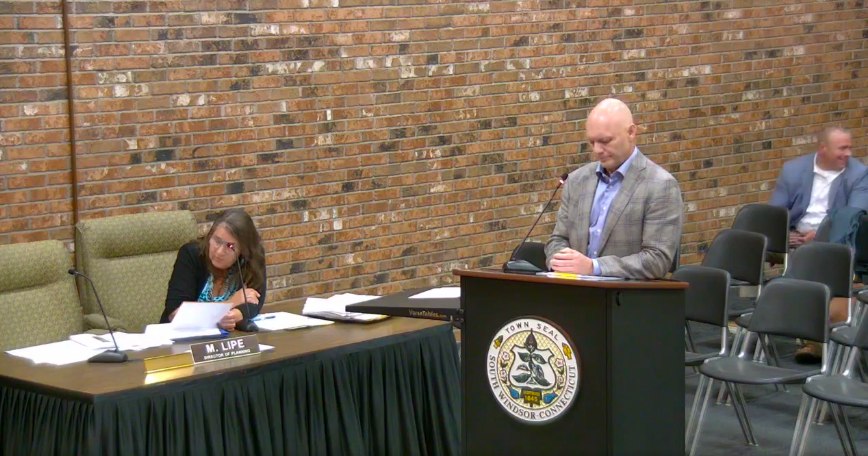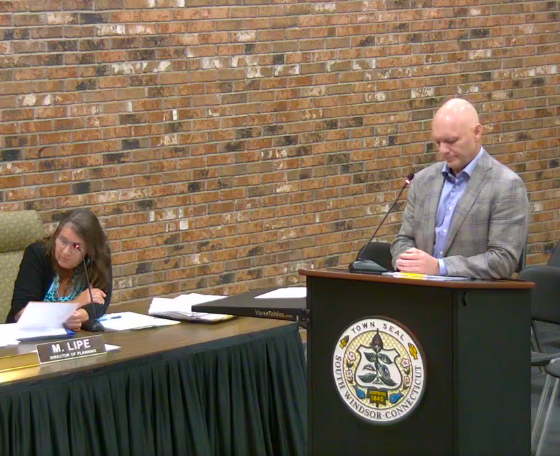

News
CT Dealership said “direct sales EVs like Tesla are a very small percentage of the vehicles sold”
A Connecticut dealership employee said at a planning and zoning meeting that “direct sales EVs like Tesla are expensive luxury vehicles and they are a very small percentage of the vehicles sold.” The dealership employee who made that claim works for Hoffman Auto Group.
This is a follow-up to our earlier report that Tesla cut ties with South Windsor after siding with the local dealerships.
Tesla was looking to purchase a new location for a new service center and gallery. In this area, Tesla would complement stores such as Apple. All Tesla would need the town to do is adjust the zoning laws to allow car sales and service.
The South Windsor, CT Facebook page shared a live stream of the meeting and you can watch the replay here.
Dealership sales rep: “Direct sales EVs Tesla are a very small percentage of the vehicles sold”
Tyrrell Dabrowski, sales director at Hoffman Auto Group could be seen laughing at around 1:30:10 which is when the statement about Hoffman suing towns was read aloud.
He also spoke beginning at 1:58 into the meeting. In his speech, he claimed that Tesla owners can’t get good service. I’m not sure if he was boasting or actually taking himself seriously about this since Hoffman Auto Group is blocking Tesla from serving its customers.
“The Hoffman Auto Group, you know, we’re committed to defending the dealer franchise system because it provides the consumers with benefits and protections.”
Dabrowski added that the dealer franchise system “keeps prices low by fostering fair and healthy competition on a level playing field. Direct sales by manufacturers is not necessary for the rapid introduction of EVs in the State of Connecticut. Direct sales EVs like Tesla are expensive luxury vehicles and they are a very small percentage of the vehicles sold.”
Other Dealership Testimonies
Mitchell Sealing Ford testified that Tesla is terrible and illegal. And the Connecticut Automotive Retailers Association claimed that Tesla is trying to sell vehicles in South Windsor which is illegal.
Unfortunately for Tesla, the change was voted down and the location is dead. It’s another win for dealerships–especially those who are spreading misinformation.
Hoffman Auto Group’s Claim Debunked
The claim that direct sales EVs like Tesla are only luxury cars and make up a small percentage of sales is highly misleading.
Tesla is not only the global EV leader, but during the first half of 2022 alone, Tesla delivered 564,000 vehicles which represented a growth increase of 27% year-over-year.
During Tesla’s Q2 2022 earnings call, Elon Musk said that he is confident that Tesla would be able to get to 5,000 cars a week in Austin and Berlin by the end of this year.
“There’s always a lot of uncertainty like the production looks like S-curve, and that intermediate part of S-curve the difficult to bridge that with high certainty. But the end part of the S-curve, you can say, I think you can have a lot more certainty.”
“And so that’s why I’m confident we’ll get to 5,000 cars a week at — in Austin and Berlin by the end of this year or early next year and probably but not certainly, 10,000 cars a week at both locations by the end of next year.”
Statement from Tesla Owners of Connecticut
The Tesla Owners Club of Connecticut shared the following statement with me in an email:
“Unfortunately, once again Tesla was kicked to the curb. Legacy dealerships have an awful reputation. South Windsor didn’t want to open up pandora’s box to any dealership coming into this beautiful part of their town. “
“It was painful to listen to the dealer’s disparaging testimony. Their backward thinking and anti-competitive remarks will lead them to bankruptcy eventually. “
My Previous coverage of Hoffman Auto Group & Tesla
When I wrote for CleanTechnica, I extensively covered the ongoing drama that Hoffman Auto Group caused.
- In June 2021, Hoffman Auto Group sued Tesla and the Town of East Hartford because they didn’t want Tesla to sell to customers.
- In June 2021, Hoffman’s Bradley Hoffman told Senator Haskell, that dealers have spent millions on charging stations and solar panels. I replied to him on Twitter asking him to share where he got that information from. He never replied.
- In August 2021, East Hartford approved the Tesla Service Center—but that didn’t last for long.
- Once the Tesla service center was approved, Hoffman sued Tesla.
- In September 2021, I wrote about why dealerships don’t want to compete with Tesla.
- And in March 2022, I reported on East Hartford ruling in favor of Hoffman and other dealerships regarding Tesla and its new service center.
- My interview with Senator Will Haskell

News
Tesla FSD fleet is nearing 7 billion total miles, including 2.5 billion city miles
As can be seen on Tesla’s official FSD webpage, vehicles equipped with the system have now navigated over 6.99 billion miles.

Tesla’s Full Self-Driving (Supervised) fleet is closing in on almost 7 billion total miles driven, as per data posted by the company on its official FSD webpage.
These figures hint at the massive scale of data fueling Tesla’s rapid FSD improvements, which have been quite notable as of late.
FSD mileage milestones
As can be seen on Tesla’s official FSD webpage, vehicles equipped with the system have now navigated over 6.99 billion miles. Tesla owner and avid FSD tester Whole Mars Catalog also shared a screenshot indicating that from the nearly 7 billion miles traveled by the FSD fleet, more than 2.5 billion miles were driven inside cities.
City miles are particularly valuable for complex urban scenarios like unprotected turns, pedestrian interactions, and traffic lights. This is also the difference-maker for FSD, as only complex solutions, such as Waymo’s self-driving taxis, operate similarly on inner-city streets. And even then, incidents such as the San Francisco blackouts have proven challenging for sensor-rich vehicles like Waymos.
Tesla’s data edge
Tesla has a number of advantages in the autonomous vehicle sector, one of which is the size of its fleet and the number of vehicles training FSD on real-world roads. Tesla’s nearly 7 billion FSD miles then allow the company to roll out updates that make its vehicles behave like they are being driven by experienced drivers, even if they are operating on their own.
So notable are Tesla’s improvements to FSD that NVIDIA Director of Robotics Jim Fan, after experiencing FSD v14, noted that the system is the first AI that passes what he described as a “Physical Turing Test.”
“Despite knowing exactly how robot learning works, I still find it magical watching the steering wheel turn by itself. First it feels surreal, next it becomes routine. Then, like the smartphone, taking it away actively hurts. This is how humanity gets rewired and glued to god-like technologies,” Fan wrote in a post on X.
News
Tesla starts showing how FSD will change lives in Europe
Local officials tested the system on narrow country roads and were impressed by FSD’s smooth, human-like driving, with some calling the service a game-changer for everyday life in areas that are far from urban centers.

Tesla has launched Europe’s first public shuttle service using Full Self-Driving (Supervised) in the rural Eifelkreis Bitburg-Prüm region of Germany, demonstrating how the technology can restore independence and mobility for people who struggle with limited transport options.
Local officials tested the system on narrow country roads and were impressed by FSD’s smooth, human-like driving, with some calling the service a game-changer for everyday life in areas that are far from urban centers.
Officials see real impact on rural residents
Arzfeld Mayor Johannes Kuhl and District Administrator Andreas Kruppert personally tested the Tesla shuttle service. This allowed them to see just how well FSD navigated winding lanes and rural roads confidently. Kruppert said, “Autonomous driving sounds like science fiction to many, but we simply see here that it works totally well in rural regions too.” Kuhl, for his part, also noted that FSD “feels like a very experienced driver.”
The pilot complements the area’s “Citizen Bus” program, which provides on-demand rides for elderly residents who can no longer drive themselves. Tesla Europe shared a video of a demonstration of the service, highlighting how FSD gives people their freedom back, even in places where public transport is not as prevalent.
What the Ministry for Economic Affairs and Transport says
Rhineland-Palatinate’s Minister Daniela Schmitt supported the project, praising the collaboration that made this “first of its kind in Europe” possible. As per the ministry, the rural rollout for the service shows FSD’s potential beyond major cities, and it delivers tangible benefits like grocery runs, doctor visits, and social connections for isolated residents.
“Reliable and flexible mobility is especially vital in rural areas. With the launch of a shuttle service using self-driving vehicles (FSD supervised) by Tesla in the Eifelkreis Bitburg-Prüm, an innovative pilot project is now getting underway that complements local community bus services. It is the first project of its kind in Europe.
“The result is a real gain for rural mobility: greater accessibility, more flexibility and tangible benefits for everyday life. A strong signal for innovation, cooperation and future-oriented mobility beyond urban centers,” the ministry wrote in a LinkedIn post.
News
Tesla China quietly posts Robotaxi-related job listing
Tesla China is currently seeking a Low Voltage Electrical Engineer to work on circuit board design for the company’s autonomous vehicles.

Tesla has posted a new job listing in Shanghai explicitly tied to its Robotaxi program, fueling speculation that the company is preparing to launch its dedicated autonomous ride-hailing service in China.
As noted in the listing, Tesla China is currently seeking a Low Voltage Electrical Engineer to work on circuit board design for the company’s autonomous vehicles.
Robotaxi-specific role
The listing, which was shared on social media platform X by industry watcher @tslaming, suggested that Tesla China is looking to fill the role urgently. The job listing itself specifically mentions that the person hired for the role will be working on the Low Voltage Hardware team, which would design the circuit boards that would serve as the nervous system of the Robotaxi.
Key tasks for the role, as indicated in the job listing, include collaboration with PCB layout, firmware, mechanical, program management, and validation teams, among other responsibilities. The role is based in Shanghai.
China Robotaxi launch
China represents a massive potential market for robotaxis, with its dense urban centers and supportive policies in select cities. Tesla has limited permission to roll out FSD in the country, though despite this, its vehicles have been hailed as among the best in the market when it comes to autonomous features. So far, at least, it appears that China supports Tesla’s FSD and Robotaxi rollout.
This was hinted at in November, when Tesla brought the Cybercab to the 8th China International Import Expo (CIIE) in Shanghai, marking the first time that the autonomous two-seater was brought to the Asia-Pacific region. The vehicle, despite not having a release date in China, received a significant amount of interest among the event’s attendees.








